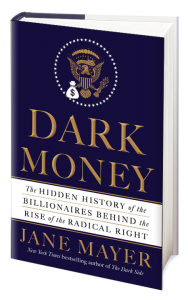By Elliott Brack, editor and publisher | It may be one of the most important books of recent times, in that is shows our country what big money can do in government. The book is Dark Money, by Jane Mayer, a staff writer for The New Yorker. The subtitle is The Hidden History of the Billionaires Behind the Rise of the Radical Right.
 The book traces the way big money is used to move the agenda of our nation…..and meanwhile, helping benefit those with……big money.
The book traces the way big money is used to move the agenda of our nation…..and meanwhile, helping benefit those with……big money.
It traces the Koch family, Richard Mellon Scaife, John M. Olin, and the Bradley Brothers. While by definition, it does not seek to highlight the billionaires on the left who want to move their agendas (read George Soros, et al), it still remains worthy as it details the shenanigans used to try to influence our nation.
Particularly what makes the book worthy is the fact that these billionaires are using government via the creation of non-profit entities, and getting a tax write-off for millions of dollars of contributions to these non-profits, all to benefit themselves. They could not easily have as much power over our government without using tax-deductible contributions, to see their ideas put in common use…..and eventually gain their own advantage.
To understand how deeply this is ingrained in our tax system today, look at the history of the non-profit foundation. John D. Rockefeller sought permission in 1909 from Congress to set up a private foundation whose broad mission would be to prevent and relieve suffering and promote knowledge and progress.
There were critics, including Teddy Roosevelt, of this approach, who is on record saying “No amount of charity in spending such fortunes can compensate in any way for the misconduct in acquiring them.” Foundations as such would be a “menace to the welfare of society,” and some said they were “anti-democratic” and would “undermine political equality.” So Congress didn’t approve the measure.
So Rockefeller turned to New York state’s legislature, which eventually approved in 1913 the Rockefeller Foundation, the first of its kind, initially limited to promoting only education, science and religion.
The foundations patterned after the Rockefeller Foundation grew slowly. Only 200 foundations were in existence by 1930. But soon the growth took off, to 2,000 by 1950; to 30,000 in 1985…..to 100,000 in 2013. Wow! What growth!
Why?
 At first, the foundations were not even tax deductible. But when the federal income tax was installed in 1931, the wealthy saw a chance. They convinced Congress that “unless they were granted a special tax break, philanthropists might no longer donate their fortunes for public purposes,” Mayer says. Eventually, those giving to foundations got unlimited charitable deductions.
At first, the foundations were not even tax deductible. But when the federal income tax was installed in 1931, the wealthy saw a chance. They convinced Congress that “unless they were granted a special tax break, philanthropists might no longer donate their fortunes for public purposes,” Mayer says. Eventually, those giving to foundations got unlimited charitable deductions.
That move gave billionaires a way to cut their taxes by donations to their own privately-run foundations, then through virtual control of the foundations, determine what it would do with its money…….which might just coincidently help with their own ideas of how our nation might move to benefit the donors.
And so grew the many, many foundations, funded and run by the wealthy, making sure that the foundations got into causes that they wanted to see put forward……right wing and left wing. Those making contributions to these private foundations were trying to influence the government so that they and their children would remain in that lofty position of power.
Of course, many foundations are worthy and beneficial. We can only applaud them.
But one observer has called the way some private foundations are run today “a completely irresponsible institution, answerable to nobody.”
The big money in politics these days comes from the wealthy, through their own private foundations. Some call this anti-democratic, and not always benefitting society.
Thank you, Jane Mayer, for this solid reporting.
- Have a comment? Send to: elliott@brack.net










Follow Us